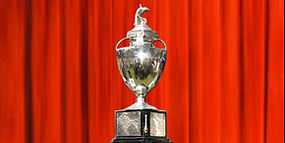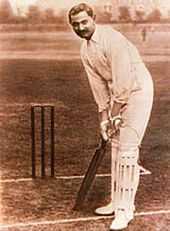Ranji Trophy
| Ranji Trophy | |
|---|---|
 | |
| Countries |
|
| Administrator | BCCI |
| First tournament | 1934 |
| Tournament format | Round-robin then knockout |
| Number of teams | 27 |
| Current champion | Karnataka (7th title) |
| Most successful | Mumbai (40 titles) |
| Most runs | Wasim Jaffer |
| Most wickets |
Rajinder Goel (640) 1958–1985 |
|
| |
The Ranji Trophy is a domestic first-class cricket championship played in India between teams representing regional cricket associations. The competition currently consists of 27 teams, with 21 of the 28 states in India and Delhi (which is an Union Territory), having at least one representation. The competition is named after England and Sussex cricketer Kumar Shri Ranjitsinhji (Jam Sahib of Nawanagar, also known as "Ranji"). Karnataka are the current Ranji champions beating Maharashtra by 7 wickets in the finals held in Hyderabad.
History

The competition was launched as "The Cricket Championship of India" following a meeting of the Board of Control for Cricket in India in July 1934, with the first fixtures taking place in 1934–35. The trophy was donated by Maharaja Bhupinder Singh of Patiala. The first Ranji Trophy Championship was won by Bombay after they defeated North India in the final. Syed Mohammed Hadi of Hyderabad was the first batsman to score a hundred.
Mumbai (formerly Bombay) have been the dominant team in the Championship so far, with 40 wins, including 15 back-to-back wins from 1958–59 to 1972–73.
Participants
State teams and cricket associations and clubs with first-class status are qualified to play in the Ranji Trophy. While most association are regional, like the Tamil Nadu Cricket Association and Mumbai Cricket Association some are pan-Indian like Railways and Services.
Defunct Ranji Trophy Teams
The following sides have appeared in the Ranji Trophy, but no longer do so: Southern Punjab (1934/35-1967/68), Sind (1934/35-1947/48), Northern India (1934/35-1946/47), Central Provinces & Berar (1934/35-1949/50), Western India (1934/35-1945/46), North West Frontier Province (1937/38-1946/47), Holkar (1941/42-1954/55) Gwalior (1943/44), Kathiawar (1946/47-1949/50), Patiala/Patiala and Eastern Punjab States Union (1948/49, 1953/54-1958/59), Eastern Punjab (1950/51-1959/60), Madhya Bharat (1955/56-1956/57), Northern Punjab (1960/61-1967/68).
Format
From its inception until the 2001–02 season, the teams were grouped geographically into four or five zones – North, West, East, and South, with Central added in 1952–53. Initial matches were played within the zones on a knock-out basis until 1956–57, and thereafter on a league basis, to determine a winner; then, the five individual zone winners competed in a knock-out tournament, leading to a final which decided the winner of the Ranji Trophy. From the 1970–71 season, the knock-out stage was expanded to the top two teams from each zone, a total of ten qualifying teams. This was expanded again to the top three from each zone in 1992–93, a total of fifteen qualifying teams; between 1996–97 and 1999–2000, the fifteen qualifying teams competed in a secondary group stage, with three groups of five teams, and the top two from each group qualified for a six-team knock-out stage; in all other years until 2001-02, a full fifteen-team knock-out tournament was held.
The format was changed in the 2002–03 season with the zonal system abandoned and a two-division structure adopted – the Elite Group, containing fifteen teams, and the Plate Group, containing the rest. Each group had two sub-groups which played a round-robin; the top two from each Elite sub-group then contested a four-team knock-out tournament to determine the winner of the Ranji Trophy. The team which finished last in each Elite sub-group was relegated, and both Plate Group finalists were promoted for the following season. For the 2006–07 season, the divisions were re-labelled the Super League and Plate League respectively.
In the 2008–09 season, this format was adjusted to give both Super League and Plate League teams an opportunity to contest the Ranji Trophy. The top two from each Plate sub-group contested semi-finals; the winners of these two matches then joined the top three from each Super League sub-group in an eight-team knock-out tournament. The winner of this knock-out tournament then won the Ranji Trophy. Promotion and relegation between Super League and Plate League continued as before. In the 2010–11 season, Rajasthan won the Ranji Trophy after beginning the season in the Plate League.
From the 2012–13 season, this format was adjusted slightly. The Super League and Plate League names were abandoned, but the two-tier system remained. The top tier expanded from fifteen teams to eighteen teams, in two sub-groups of nine (known as Group A and Group B, and considered equal in status); and the second tier was reduced to nine teams in a single group (known as Group C). The top three teams from Groups A and B and the top two from Group C contest the knockout phase. The lowest placed team in each of Group A and Group B is relegated to Group C, and the top two from Group C are promoted to the top tier.
Round-robin matches are four days in length; knockout matches are played for five days. Throughout its history, if there is no outright result in a Ranji Trophy knock-out match, the team leading after the first innings is the winner.
Points summary
Points in the league stages of both divisions are currently awarded as follows:
| Scenario | Points |
|---|---|
| Win outright | 6 |
| Bonus point (for innings or 10 wicket wins) | 1 |
| 1st innings lead in a drawn match | 3 * |
| No result | 1 |
| 1st innings deficit in a drawn match | 1 * |
| Lost Outright | 0 |
Teams
For a complete list of teams which have played in the competition at some point during its history, see Ranji Trophy – Historical Note.
|
Group A |
Group B
|
|
Group C
SeasonsCurrent seasonPrevious seasons
Tournament recordsMain article: List of Ranji Trophy records
† Some sources credit Goel with 636 or 637 wickets instead – see Rajinder Goel article for details. WinnersFinals appearances by teamThe Bombay\Mumbai cricket team has played in 44 of the 79 Finals through 2013 and have won 40 Ranji Trophy championships, the most of any team.
See also
References and notes
External links
Template:Ranji Trophy seasons
| ||||||||||||||||||||||||||||||||||||||||||||||||||||||||||||||||||||||||||||||||||||||||||||||||||||||||||||||||||||||||||||||||||||||||||||||||||||||||||||||||||||||||||||||||||||||||||||||||||||||||||||||||||||||||||||||||||||||||||||||||||||||||||||||||||||||||||||||||||||||||||||||